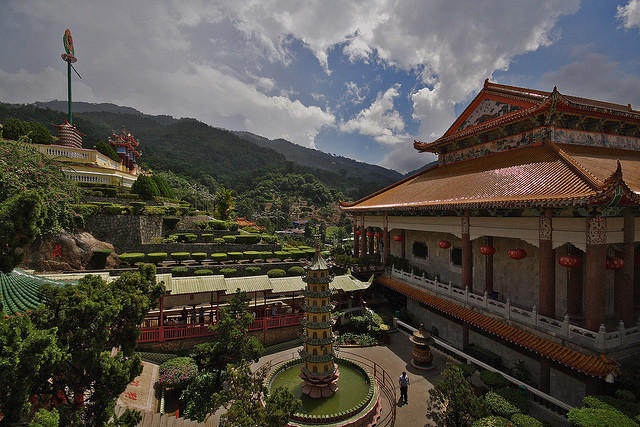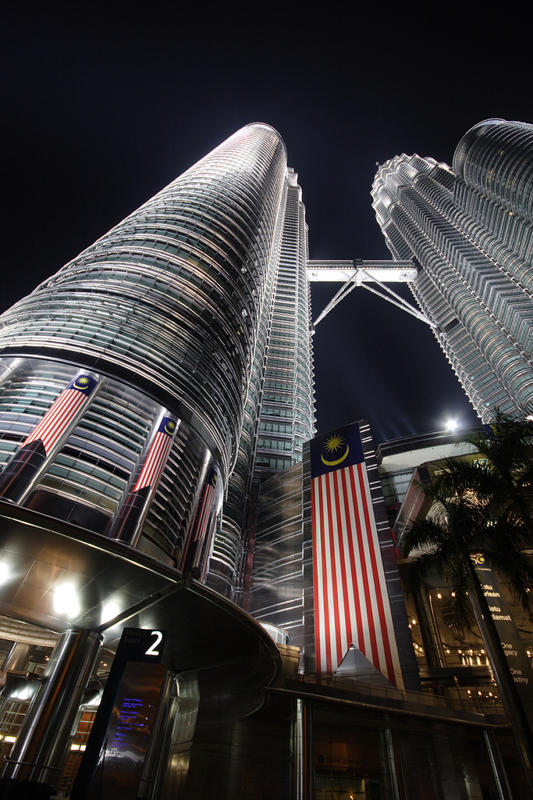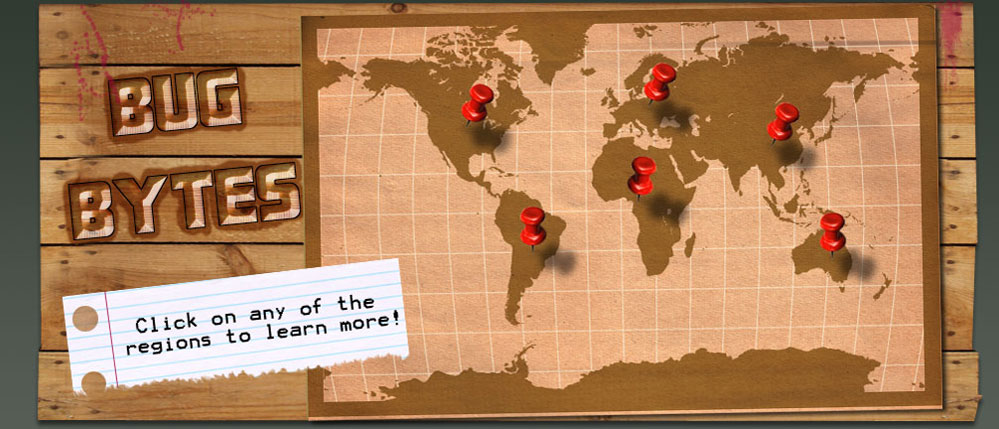
This week’s Bug Bytes is with Magda Biskup, an amazing photographer, traveler and creator of Destination World.
Magda has lived in various countries around the world, including Malaysia.
Here, she gives us the scoop on social customs to be aware of, the foods that will make you salivate, how to get around, and more!
###
BB: You once lived in Malaysia. What part? What brought you there?
MB: In 2003 I spent 10 months living and working in a town called Perai in the state of Penang. It’s in the north-west part of the country, about 350km north of Kuala Lumpur and about 30-minute drive from beautiful Georgetown on Penang Island.
A year earlier I had applied for an international internship program with student organisation called AIESEC. They have branches in most counties and they look for businesses all over the world that want to employ foreign graduates.
BB: What was your initial reaction to the country? What did you think after landing?
MB: It was the first time I’d even been to Far East, so I went through full on cultural shock. The fact that I was the only foreigner in town didn’t help either. People started at me and pointed me out. Everything was different from food to traffic rules and from work etiquette to the weather. But I very quickly got used to it all and after the first few weeks which were pretty hard I was absolutely in love with Malaysia.

Malaysia
BB: What was your accommodation like? Was it expensive? Inexpensive?
MB: I was pretty lucky, as the company I worked for had an apartment for some staff that lived interstate. I shared this place with a few other people and I didn’t have to pay for it. But having said that, the rental prices were very affordable. I had some friends in KL and they were able to get a really nice furnished condo, despite the fact that they were paid intern salaries.
BB: I know this is silly, but I don’t know much about Malaysia. I’m interested in knowing what the cities are like. If you could describe Kuala Lumpur in 3 words, what would they be, and why?
MB: Generally speaking Asian cities are not very pretty when it comes to architecture and use of public space, and Malaysia is no exception, but they are still very fascinating places. Kuala Lumpur is a great mix of history, tradition and modernity.
BB: Glad you mentioned that! We love food around here! What should we try? What should we avoid? haha.
MB: Oh, the food is probably the best thing there is in Malaysia. It’s magnificent. The variety is amazing and the main reason for that is that Malaysia is a multicultural society, with large percentage of Indians and Chinese.
My favorite food in Malaysia in Mamak food, which is basically food of Indian Muslims. It’s a combination of Indian and Malay cuisine.
There is lots of amazing local dishes everyone should try. I love roti chanai (Indian bread), all kinds of noodles (char kwey toew is my favorite) and local laksa. There are some weird stuff as well, like rojak (fruit salad with salty prone paste) or strange ice desserts with beans, but overall the food in Malaysia is magnificent.
Malaysian Food
BB: What are the people like?
MB: Asia is culturally very different from Europe, so people are also different in the way they go about their everyday lives. It was a fascinating thing for me to watch them and learn their way.
My observation was that religion plays very big role in their lives. And it’s not that they are extremely devoted, it’s just seems that it’s something that in a way dictates the rules.
But apart from that, they are very friendly people – you just need to make an effort to get to know them. They can be a bit shy when dealing with foreigners, but once you get to know them they are lovely.
BB: So what is the religious make-up of the country like? And languages?
MB: The majority of the society are Malay people (the same ethnic group as the people of Indonesia). They make about 65% of the entire population. They speak Malay which is also Malaysia’s official language. Pretty much all of them are Muslims.
The second biggest group are people of Chinese decent. They make about 24% of the entire population. They first arrived in Malaysia at the beginning of XIX century. Their first language is usually Mandarin, Hokkien or Cantonese (quite often they know speak than one Chinese dialect), but all of them also speak Malay and pretty good English.
It’s not uncommon to meet Chinese Malaysian speaking fluently in four languages.
Majority of them are Buddhists and a small percentage are Christians. About 7% of Malaysian citizens are of Indian origin. Most of them are descendants of laborers brought to Malaysia by British to work on local farms. They all speak one of the south Indian dialects (mostly Tamil), but also Malay and quite often good English. They are either Hindu or Muslims, sometimes Christians.
There is also a small group of people called Orang Asli (meaning Original People) and some tribal people living in Borneo (part of which belongs to Malaysia). So as you can see it’s a pretty mixed and very vibrant society. And I believe this is what makes Malaysia so unique and interesting.

Petronas Towers
BB: That’s really interesting! How does the country differ between the different regions?
MB: The west coast of Malay Peninsula is very modern, both economically and culturally. This is where the society is most mixed and you can see it on every corner. Here you have Malay women wearing colorful robes covering from head to toe (however they don’t cover their faces) and Chinese teenagers wearing super short skirts.
The east cost is populated mostly by Malays, so it’s a bit more traditional. I found Sarawak and Sabah, two Malaysian states on Borneo island, to be the most relaxed part of the country.
BB: Are there any social customs we should be aware of before we go?
MB: With majority of Malaysian people being Muslims, the custom number one to follow would be the left hand rule.
Since in Muslim culture left hand is reserved for washing after using toilet it’s considered unclean and shouldn’t be used when dealing with other people. So for example if you go to the shop and want to pay you can’t do it using your left hand (people use either their right hand or both hands).
It’s the same when it comes to eating – lots of food in Malaysia is eaten with hands (and not with cutlery), so it’s the right hand that should be used to put food in your mouth.
There are lots of other small things that I picked up during those 10 months but for those who just go traveling to Malaysia I wouldn’t stress too much about them. The left hand rule is the only one that I recommend following.
BB: What’s the best way to get around town?
MB: There is a public transport in Penang, and since I didn’t have a car or a scooter (the latter being the most popular mode of transport in Malaysia) I used it a lot. And it wasn’t too bad actually. The buses were really old, but at the same time they were very cheap and it was possible get pretty much anywhere with them.
BB: How would you spend a lazy Sunday??
MB: I usually would go to Georgetown to wander the colorful streets of Chinese or Indian district or just to try something new to eat 🙂 I’d also go for a day trips around Penang with some friends or if I managed to get a few days off to other parts of Malaysia.
###
Thanks so much for your answers and photos Magda! To find out more about Magda, visit her awesome blog,
Destination World, follow her on Twitter @DestinationWorld or check out her
Facebook page .
Bug Bytes is a weekly feature in which travelers tell us about the places they’ve lived and what makes those places awesome. Interested in taking parts in Bug Bytes? Lived somewhere cool and want to tell us about it?
Email Kelly at travelbugjuice@gmail.com
Tagged as:
Bug Bytes










{ 5 comments… read them below or add one }
I love learning about other cultures and this was no exception. The left hand rule seems to be very important. I don’t want to mess that one up when I finally visit thanks for the heads up! I think bug bytes is one of my new favorite series. Thanks Kelly and thanks Magda!
Malaysia sounds like such a beautiful, diverse place! Thanks for sharing your experience.
I really enjoyed this Q&A! Malaysia sounds fascinating to me. Hopefully I’ll get the opportunity to visit someday. The food sounds yummy too! 😉
Love these interviews. Whilst I’m at it: did you ever get my answers to your questions which I sent you a while ago?
Thanks Scott! Perhaps you’d like to partake in a Bug Bytes? Just let me know!
{ 1 trackback }